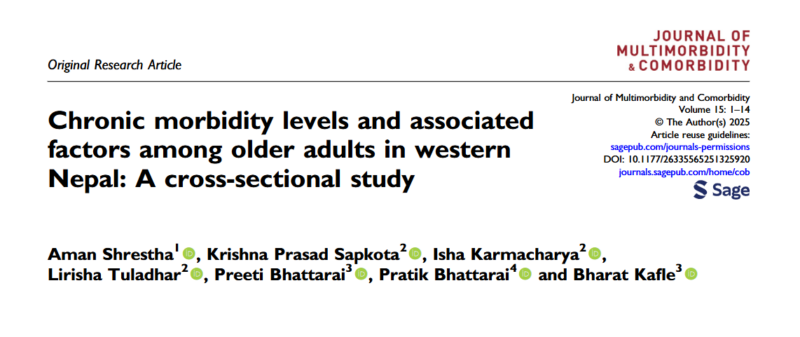Aman Shrestha, Graduate Research Assistant at Institute for Genome Sciences, University of Maryland Baltimore, shared a post on LinkedIn:
“I am pleased to share our newly published study in the Journal of Multimorbidity and Comorbidity explored the burden of chronic diseases among older adults in western Nepal. Our study spanned across all three ecological regions — mountain , hill and plains — in Gandaki province.
We found that 40% reported a single chronic condition and 25% had multimorbidity—most commonly musculoskeletal issues, hypertension, and respiratory problems. The most frequent comorbid pair was hypertension and musculoskeletal disorders, followed by musculoskeletal with respiratory conditions.
Older age and female gender were associated with higher morbidity, while lack of healthcare visits suggested possible underdiagnosis. These findings highlight the urgent need for regular screenings, gender-sensitive care, and improved access to preventive services as Nepal’s population continues to age.
This work wouldn’t have been possible without sincere efforts from all of my collaborators: Krishna, Bharat, Isha, Lirisha, preeti and Pratik – thank you all.
Here is the link to our published work.
Chronic morbidity levels and associatedfactors among older adults in westernNepal: A cross-sectional study.
Authors: Aman Shrestha, Krishna Prasad Sapkota at al.

Krishna Prasad Sapkota, Graduate Assistant at Scripps Gerontology Center, shared this post, adding:
“We found that 40% of older adults reported a single chronic condition, and 25% had multimorbidity—most commonly musculoskeletal issues, hypertension, and respiratory problems.
Health professionals need to be ready to screen older adults for multimorbidity if they find a chronic disease and also to manage multimorbidity.
PS: This study is useful for anyone who wants to learn how to interpret ordinal logistic regression results and report bivariate results scientifically.”
Runcie C.W. Chidebe, Executive Director at Project PINK BLUE, shared this post, adding:
“Interesting findings. There are so many important areas of thought.
‘Participants who did not visit healthcare facilities in the past year were associated with lower odds of increased chronic morbidity than those who had visited healthcare facilities.’
Even in Nigeria, many OAs would ask why they should visit a healthcare facility when they are not sick.
Congratulations to Krishna Prasad Sapkota, Aman Shrestha, Isha Karmacharya and the team for this important study.”
More posts featuring Runcie C.W. Chidebe.
